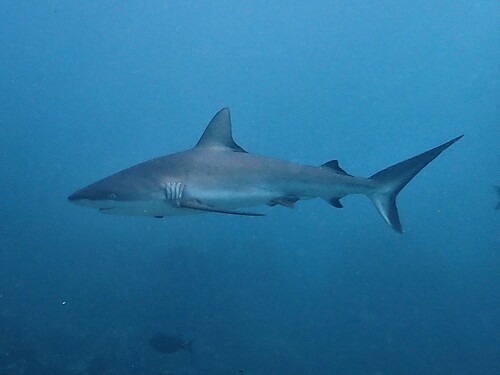
Grey Reef Shark
The Atlantic bluefin tuna (Thunnus thynnus) is a highly migratory, large pelagic fish renowned for its size, speed, and commercial value. It plays a crucial role in the marine ecosystem and is a top predator.
20 25 years
Lifespan
185 - 200 cm
Length
Near Threatened
Conservation Status
43 km/h
Swimming speed
Carnivorous
Diet
Local Migration
Migration
Appearance Overview
The Atlantic bluefin tuna is a large, torpedo-shaped fish with a metallic blue-black back and a silvery-white underside.
Coloration
Dark metallic blue on top, silvery-white underside
Fins
Two dorsal fins, the first depressible into a groove
Body Shape
Torpedo-shaped, streamlined for speed
Finlets
Small finlets located behind the second dorsal and anal fins
Length
Up to 13 feet (4 meters)
Weight
Up to 2,000 lbs (907 kg)
Diet
Carnivorous, feeding on a variety of fish, squid, crustaceans, and eels.
Feeding Behavior
Opportunistic and highly mobile predators, they use their speed and agility to hunt, often feeding near the surface but also diving deep.
Social Behavior
Forms large schools, especially when young; older fish may be solitary or form smaller groups. Highly migratory.
Commercial Relevance
Extremely high value, particularly in the Japanese sushi and sashimi market, where a single fish can fetch hundreds of thousands of dollars.
Conservation measures
International fishing quotas, seasonal closures, minimum size limits, and monitoring programs are in place. Some organizations promote sustainable aquaculture.
Status
Varies by population; Western Atlantic stock is considered Endangered, while the Eastern Atlantic and Mediterranean stock is considered Near Threatened.
Threats
Overfishing (historically and a continuing threat), illegal fishing, bycatch in other fisheries, and habitat degradation.
Habitat Distribution
Depth Range
0-1,000 meters (0-3,280 feet), but most commonly found in the upper 200 meters.
Geographic Range
Atlantic Ocean, Mediterranean Sea, and formerly in the Black Sea.
Preferred Environment
Temperate and subtropical waters; pelagic (open ocean) species, often associated with temperature fronts and upwelling areas.
Reproduction and Life Cycle
Breeding Habits
Spawns in specific areas (Gulf of Mexico and Mediterranean Sea) during specific seasons, with females releasing millions of eggs.
Development Stages
Eggs hatch into larvae, which develop rapidly, feeding on plankton and growing into juveniles, then adults.
Fecundity
High fecundity; females can produce up to 30 million eggs per spawning season.
Maturity Age
Varies by population; Western Atlantic stock matures around 8-12 years, Eastern Atlantic stock around 4-5 years.
Faqs about Grey Reef Shark
How long do Atlantic bluefin tuna live?
They can live up to 40 years, although this is rare due to fishing pressure.
How fast can they swim?
They are among the fastest fish in the ocean, capable of bursts of speed up to 40-60 mph.
Are bluefin tuna warm-blooded?
Yes, they are warm-blooded, which allows them to maintain a higher body temperature than the surrounding water, aiding in muscle efficiency and speed.
Where do Atlantic Bluefin tuna spawn?
The Western Atlantic stock spawns in the Gulf of Mexico, while the Eastern Atlantic and Mediterranean stock spawns in the Mediterranean Sea.
Do Atlantic Bluefin tuna migrate?
They undertake extensive migrations across the Atlantic Ocean, both for feeding and spawning.
How many eggs does a bluefin tuna lay?
A female bluefin tuna can release up to 30 million eggs per spawning season.
What are the predators of the Atlantic Bluefin tuna?
They are apex predators, with few natural predators besides large sharks and orcas when young.
What is the difference between Western and Eastern Atlantic Bluefin tuna?
The main difference is their spawning grounds; the Western stock spawns in the Gulf of Mexico, and the Eastern stock spawns in the Mediterranean Sea.
Why are bluefin tuna so expensive?
The high demand for sushi and sashimi, combined with slow maturation and historical overfishing, has driven prices very high.
How can I help protect bluefin tuna populations?
Consumers can choose seafood from sustainable sources, support organizations working to protect bluefin tuna, and advocate for responsible fishing policies.
Copyright @ Nature Style Limited. All Rights Reserved.
 English
English